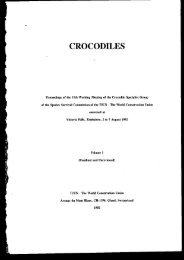size: 5405KB - Crocodile Specialist Group
size: 5405KB - Crocodile Specialist Group
size: 5405KB - Crocodile Specialist Group
You also want an ePaper? Increase the reach of your titles
YUMPU automatically turns print PDFs into web optimized ePapers that Google loves.
<strong>Crocodile</strong> <strong>Specialist</strong> <strong>Group</strong> Steering Committee Meeting<br />
Goldi Sands Hotel, Negombo, Sri Lanka<br />
20 May 2013 (8.30 am-5.00 pm)<br />
Agenda Item SC.2.3<br />
Information Item<br />
East and Southeast Asia Regional Report<br />
Report on Activities:<br />
Lao PDR: (Alex McWilliam, Lao PDR Program Operations Manager, WCS)<br />
Community Based <strong>Crocodile</strong> Recovery and Livelihood Improvement Project (CBCRLIP):<br />
The current project (October 2009-December 2013) is to implement the CBCRLIP in accordance<br />
with the MoU with the PAFO of Savanakhet Province, signed on 30 April 2010. This is the third<br />
phase of this ongoing project; Phases 1 and 2 were completed in 2009.<br />
The goal for each project site is recovery of the local crocodile population and restoration of<br />
associated wetlands, linked by socio-economic incentives that substantially improve local<br />
livelihoods. The specific objectives of the project as stated in Section 3.1 of the MOU are:<br />
1. Livelihood improvement. Improvement of local livelihoods is mainly linked to alternate<br />
sourcing of water and earthmoving initiatives that create new bodies of water. If the crocodile<br />
recovery is successful, tourism will be new source income.<br />
2. Wetlands conservation. <strong>Crocodile</strong> habitat at most project sites is moderately to heavily<br />
disturbed by local people striving to satisfy their basic economic needs. A key strategy in<br />
restoring wetlands important for crocodiles and long-term conservation is to shift pressure<br />
away from these sites. This will be done by providing alternatives, awareness and law<br />
enforcement.<br />
3. <strong>Crocodile</strong> replenishment. ‘Headstarting’ is the method of choice to boost small existing<br />
populations at several sites and re-introduce crocodiles at sites where suitable habitat exists or<br />
can be restored. Relocated baby crocodile will come for the Ban Khern Zoo.<br />
4. Project implementation. Implementation will be co-managed by a <strong>Crocodile</strong> Project Unit<br />
consisting of PAFO and DAFO, members of local communities and WCS. WCS staff will at<br />
every stage build Lao staff capacity to eventually sustain project activities.<br />
Current progress of the project according to these objectives and activities mentioned in Section 3.2<br />
of the MOU are presented in the table below. A short description of additional activities to be<br />
completed to 31 December 2013 is also presented in the table below.<br />
Table 1. Activities, current results, and further planned activities of the CBCRLIP.<br />
Activity Results Further planned activities<br />
DNA determination and<br />
‘head-starting’<br />
We have assessed the DNA of 21 adults at the<br />
Lao Zoo which may potentially be used for<br />
captive breeding of Siamese crocodiles that<br />
may be released to the wild. Of these 10<br />
Now that we have identified the pure<br />
Siamese crocodiles at the Lao Zoo<br />
and started the captive breeding<br />
program it is important to continue

















